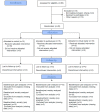The use of virtual reality for Peri-procedural pain and anxiety at an outpatient spine clinic injection visit: an exploratory controlled randomized trial
- PMID: 33042461
- PMCID: PMC7540157
The use of virtual reality for Peri-procedural pain and anxiety at an outpatient spine clinic injection visit: an exploratory controlled randomized trial
Abstract
Chronic pain is a major public health problem. There is a need to develop novel treatment strategies to address this growing issue. Virtual reality is emerging as an alternative approach to help people suffering from chronic pain. The purpose of this work was to explore the feasibility, acceptability, and impact of a brief virtual reality relaxation video on peri-procedural pain and anxiety in chronic low back pain patients receiving spinal injections. The intervention was delivered in the context of a busy fluoroscopy injection clinic. Upon arrival to the clinic, consented patients were randomized into one of three groups: (1) Audiovisual monitor-flat screen (AV) (2) Virtual Reality headset (VR) and (3) Control-no intervention. The main questions we set out to answer were: (1) Is it feasible to deliver the intervention in the context of clinical care? (2) Was the intervention acceptable to patients? and (3) Did the intervention impact pain and anxiety surrounding the injection procedure? Viewing a brief relaxation nature video in AV or VR format was not associated with statistically lower pain scores following an injection procedure compared to controls. However, the intervention was associated with lower anxiety scores recorded prior to the injection compared to controls. Importantly, the virtual reality intervention was acceptable and feasible to integrate into a clinic setting, however, to maximize effectiveness, the content delivered to this population should be targeted and delivered over a longer duration. In addition, alternative outcomes and settings beyond peri-procedural pain surrounding an injection should be explored.
Keywords: Chronic low back pain; pain management; procedural anxiety; procedural pain; virtual reality.
AJTR Copyright © 2020.
Conflict of interest statement
None.
Figures



References
-
- Institute of Medicine (US) Committee on Advancing Pain Research, Care, and Education. Relieving {Pain} in {America}: {A} {Blueprint} for {Transforming} {Prevention}, {Care}, {Education}, and {Research} 2011 - PubMed
-
- Tracey I, Bushnell MC. How neuroimaging studies have challenged us to rethink: is chronic pain a disease? J Pain. 2009;10:1113–1120. - PubMed
-
- Booth J, Moseley GL, Schiltenwolf M, Cashin A, Davies M, Hübscher M. Exercise for chronic musculoskeletal pain: a biopsychosocial approach. Musculoskeletal Care. 2017;15:413–421. - PubMed
-
- Hoffman HG, Patterson DR, Carrougher GJ, Sharar SR. Effectiveness of virtual reality-based pain control with multiple treatments. Clin J Pain. 2001;17:229–235. - PubMed
LinkOut - more resources
Full Text Sources
